Hi-Fi Tube Audio
Introductory Disclaimer: Before beginning, I feel obliged to inform the readers of this text that my views on high quality tube audio are mostly different and quite contrary to "common knowledge and practice" established on this topic. As an engineer I stick to scientific discipline and will strike with great vengeance on any hint of religious preaching that seems to constantly dwell in the HiFi world.
First and foremost I love music, besides experimenting with electronics. Therefore I decided to wrap up all of my previous experiments (most of these done while I was still a kid) and build me a decent device that would last. I certainly proved the statement from the beginning, the moment the amplifier started working it immediately went into service, and was left aesthetically unfinished. The gray mouse-color chassis was intended as a base for some Steampunk outer finish, but precious time required to realize that project is in short supply (apparently for years now).
The Amplifier
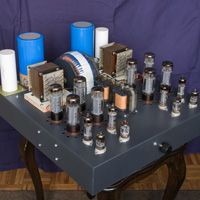 The amplifier has only one 100kOhm stereo input with line sensitivity, and a simple volume control. I skipped the input selector not just because of lack of time but because I simply hate high-impedance unbalanced signal selectors. Yes, it can all be made properly but it requires effort and there exist hard to spot pitfalls related to transient response of the signal source feeding the amplifier. So for now I decided to live with a single input, and feed the amplifier directly from the source (mostly DAC). I'm a strong opponent of preamplifiers and similar stuff that tends to complicate the signal path.
The amplifier has only one 100kOhm stereo input with line sensitivity, and a simple volume control. I skipped the input selector not just because of lack of time but because I simply hate high-impedance unbalanced signal selectors. Yes, it can all be made properly but it requires effort and there exist hard to spot pitfalls related to transient response of the signal source feeding the amplifier. So for now I decided to live with a single input, and feed the amplifier directly from the source (mostly DAC). I'm a strong opponent of preamplifiers and similar stuff that tends to complicate the signal path.Short Specification
I decided to stick with octal base output tubes as these offer an almost endless selection of types (EL34, 6L6GC, KT88, 6550, KT90...etc). The mains transformer has 5 taps to produce different anode supply voltages: 360V, 390V, 420V, 450V, and 490V. The amplifier currently employs the following tube configuration:| Input stage: | EF86, triode connected |
| Driver stage: | EL84, triode connected |
| Output stage: | 4x EL34, triode connected, "single ended" topology |
| Bias voltage regulator: | ECC88 |
| +380 VDC voltage regulator: | PCL82 |
The output transformer has an 8 Ohm output only, and the amplifier delivers around 10 W per channel.
Electrical design
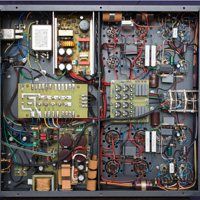 The primary focus of this amplifier's design is transient response. For this reason support circuitry is more complex and takes up space.
The primary focus of this amplifier's design is transient response. For this reason support circuitry is more complex and takes up space.In the upper left corner is the mains filter and the 6.3VDC filament switching power supply. PCB in the middle-left is a terminal hub for the toroidal mains transformer. In the lower left is the soft startup controller and to the right of it the rectifier for 380 VDC bus and bias voltage.
The right side houses the amplifier circuitry, voltage regulators and the bias adjustment PCB.
Main Anode Power Supply
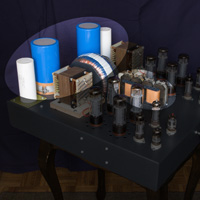 I still regret the lack of time that forced me to skip the implementation of anode power supply regulator. So instead I had to do with a more-less classical pi-filter, but properly designed for the intended purpose.
I still regret the lack of time that forced me to skip the implementation of anode power supply regulator. So instead I had to do with a more-less classical pi-filter, but properly designed for the intended purpose.For reasons I cannot understand, so many power supply filter designs in the HiFi community still (21st century) stick to the ancient approach with tiny capacitors and huge inductance. Such designs almost certainly yield filters with high Q factor and high resonant frequency that produce audible negative impact on performance. Single ended class A output stage requires a power supply filter with carefully tuned transient response, which can be obtained by large end capacitors (1000s of uF) and an exactly matching modest filter inductance and input capacitors.
However the large amount of energy stored in filtering capacitors requires careful handling, therefore an amplifier controller had to be implemented.
Amplifier Controller and Soft Startup Circuit
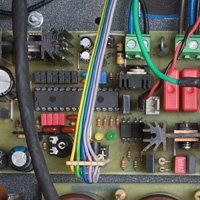 This handy device solves the problem of nasty high current surges when switching on:
This handy device solves the problem of nasty high current surges when switching on:- Rectifiers with large capacitors
- Powerful toroidal transformers
- Tubes with cold filaments
In this implementation PIC 16F73 microcontroller synchronizes with line voltage phase and drives two thyristors that slowly ramp up the voltage for the mains transformer. The overall losses are low and it proved quite reliable.
The microcontroller also handles amplifier power-on and power-off sequences. At power-on the slow ramp charges the main rectifier bulky capacitors, and subsequently powers up the tube voltage regulators. After a short delay follows the filament power of tubes of the amplifier chain. This sequence ensures stable voltages before the amplification chain wakes up.
Turn-off sequence starts with disconnection of the main rectifier supply while all tube filaments are still powered. This enables the output tubes to slowly discharge the bulky anode capacitors to safe low voltage. Without this action the shutdown would experience extreme voltage and current surges in the output stage due to disproportional shutdown speed of the input stage. A special protection circuitry is also implemented to cover the case of unexpected outside power loss.
Filament Power Supply
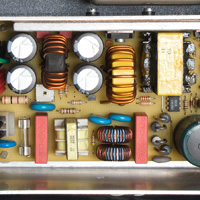 Traditional powering of tube filaments with AC voltage straight off the mains transformer is a deprecated and inadequate method to use in Hi-Fi and wide range of other tube equipment due to the following reasons:
Traditional powering of tube filaments with AC voltage straight off the mains transformer is a deprecated and inadequate method to use in Hi-Fi and wide range of other tube equipment due to the following reasons:- Unregulated filament voltage adversely affects the bias point stability and reduces design tolerances for tube spread and aging
- Unregulated high current filament power supplies exhibit difficulties in establishing the optimal filament voltage, which may push the design out of optimal performance and shorten tube life
- In indirectly heated tubes the filament-cathode isolation is subject to different kinds of deterioration during tube life. AC voltage can therefore interfere with the signal in unpredictable ways related to tube spread and aging.
- Line frequency AC voltage causes mechanical vibrations of the filament that may affect other electrodes and introduce noise in the signal
It is therefore recommended to power the filaments with regulated and filtered DC voltage. In this amplifier a "forward" type switch mode power supply with additional LF and RF suppression filtering was implemented to deliver 6.3 VDC with up to 20A.
+380 VDC and -50 VDC (Bias) Voltage Regulators
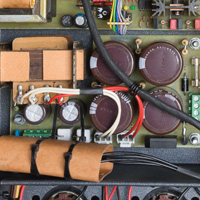 As electronic components tubes are not so good as voltage regulators, however I liked the idea of having additional tubes for the sake of aesthetics. The regulation performance can actually be quite satisfactory for the requirements, and more importantly the transient response of the feedback loop can also be nicely optimized to closely resemble a first order system, which is beneficial for Hi-Fi audio. PCL 82 (ECL 82) and ECC 88 tubes were found suitable for voltage regulator requirements.
As electronic components tubes are not so good as voltage regulators, however I liked the idea of having additional tubes for the sake of aesthetics. The regulation performance can actually be quite satisfactory for the requirements, and more importantly the transient response of the feedback loop can also be nicely optimized to closely resemble a first order system, which is beneficial for Hi-Fi audio. PCL 82 (ECL 82) and ECC 88 tubes were found suitable for voltage regulator requirements.Rectifier for the first regulator provides +500 VDC and +550 VDC. The second voltage is needed for the screen grid of the PCL 82 pentode, to improve the range of the voltage drop. Each channel has its own regulator that powers the input amplifier and the driver stage. ECC 88 based bias voltage regulator is fed with -110 VDC.
Output Transformers
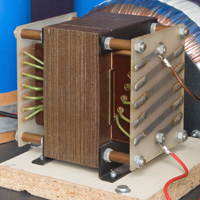 After extensive testing in the past and some simulation of wide band audio transformer design I came up with two general solutions - small and large core cross-section area. Each of these comes with compromises so the initial idea was to try them both, but since the first ones (smaller core) worked so well from the start, I kind of got stuck with them and never got to try the larger core option.
After extensive testing in the past and some simulation of wide band audio transformer design I came up with two general solutions - small and large core cross-section area. Each of these comes with compromises so the initial idea was to try them both, but since the first ones (smaller core) worked so well from the start, I kind of got stuck with them and never got to try the larger core option.Transformer design was optimized to have a "controlled capacitive prevalence" when driven by tubes, meaning that not only the first zero-pole pair is as high as possible but also that capacitive effects will already limit the modulus of the transfer function to a safe low level at those frequencies where the pole is located. In another words, the first dominant pole will have a low Q factor and much less influence on the output signal. A transformer with such properties will have a smooth transient response when driven by tubes, and the system will behave more closely to a first order system which is highly desirable. Multiple terminals for different loudspeaker impedance tend to complicate the output transformer, as it is difficult to reach optimum performance on all terminals. For that reason I opted for only one 8 Ohm output.
Single ended tube amplifier design bears an additional challenge - high magnetizing anode current requires a decrease in equivalent core permeability to avoid saturation. Adjustment of the air gap should also match the following properties of the amplifier stage:
- Output stage supply voltage and maximum amplitude of the output signal
- Impedance of the output tubes
- Low cutoff frequency of the complete amplification chain
Adopted solution yielded the following test results (transformer driven by 4x EL 34 tubes):
-1dB Cutoff: 22Hz - 120kHz
-3dB Cutoff: 12Hz - 200kHz
The anode impedance of this transformer is set to around 5000 Ohm, a rather high value for 4x EL34 but with an important reason. The greatest shortcoming of any tube amplifier is its high output impedance (low damping factor), a widely neglected fact in tube Hi-Fi world. Low damping factor signifies the inability of the amplifier to precisely control the motion of the loudspeaker membrane (under a "noisy" musical signal), most notably in bass region. Semiconductor based amplifiers much easily attain performance of quick, tight and controlled bass reproduction, while the average tube amplifier produces smeared out, "broad" sounding bass. Although this gives the impression of "warmth" and more gentle "tube-like" sound, it is actually a severe shortcoming. This issue also affects the higher frequency range, although its manifestation is not so apparent and easily identifiable compared to the lower range. Hi-Fi tube audio amplifiers are therefore bound to sacrifice a notable amount of output power to compensate for the damping factor.
How Does It Sound?
Amazingly good for my taste. The first trial run was supposed to be a start of further experiments with different tubes and other design changes, but this first configuration worked so well that it practically forced me to stick with it. I still prefer listening to music a bit more than endless experiments.The strongest first impressions were tight, quick and controlled dynamics, coupled with subjective feeling of definition, presence and space. Reproduction was clearly more on the side of precision than subjective "musicality" or "coloration" of any kind. I was glad to conclude that I like it much better that way while listening to very different music genres.
Subjective impression is much less valuable than direct comparison. One of my Hi-Fi enthusiast friends had a selection of reputable equipment for such a test: pairs of Cabasse Egea II and Iroise II loudspeakers, as a signal source we used Sony Esprit 779ES and Accuphase CD player (can't remember the exact model, but pricey), while the amplifiers to directly test against were the Accuphase E-307 and Perreaux 350 Classic Series amplifiers. Accuphase partly knocked itself out of the race for the flat "reference" amplifier by showing noticeably tone-processed low-mids (with all tone controls turned off). But we can overlook this incident as this amplifier truly has nice and crisp highs for a semiconductor amplifier and it literally wiped the floor with a couple of less fortunate tube amplifiers we compared it with.
Listening audience included a professional sound engineer/producer and a few experienced audio enthusiasts. A pretty unanimous overall conclusion was reached, beginning with all three amplifiers being virtually identical in bass reproduction. Both Cabasse II and Egea II are unfortunately amazingly wimpy (almost castrated) when it comes to bass dynamics and therefore I find them far from the best platform for such a test, but at least all amplifiers were on equal ground. I'm still under the impression that Cabasse concealed much from us in low frequencies, however even this result is in my opinion a great success for the tube amplifier. Where Cabasse truly shines is mids and highs, where we all noticed the tube amplifier standing out with a bit richer space reproduction in mids, slightly more precise details and better overall definition in higher end of the spectrum. As a final word I must again point out that the observed differences were indeed minor, and all three amplifiers fully deserve the label of premium Hi-Fi.
Why Tube Audio?
In 21st century the gap in the race between tube and semiconductor audio amplifiers has virtually vanished, semiconductors have caught up and there is no clear winner. Taboos, dogma and religious preachings in Hi-Fi are slowly crumbling against the advances in design, as the results in the industry clearly show. In the early years of semiconductors, tubes had an edge not because they were the better established technology but because the very topology of tube amplifier circuits resulted in superior transient response, which was kind of accidentally crucial to audio reproduction. Semiconductor amplifier design patterns are vastly more challenging to match the same performance, especially given that fact that quantifying and measuring such phenomena is quite difficult even today. No clear consensus yet exists in audio industry as to what exactly links the technical performance scores with subjective impressions of the human listener. But even without such a precise compass, the audio market proved big enough to develop its own positive selection and maintain progress. Apparently the exact technical explanation of why some modern design performs better than the past one does not matter much, as long as the subjective impression is undeniable.Technicalities aside, it is hard to beat the pleasing vintage aesthetics of the tube amplifier. It is undeniably amazing that this deprecated technology is still able to keep up with modern stuff, at least in this audio segment. It is also a valuable reminder that we still know very little about this amazing and incredibly sensitive natural instrument called the human ear. Sometimes I even think it might be better to leave these secrets undiscovered, for the sake of magic that surrounds audio and inspires people to creatively experiment with it.